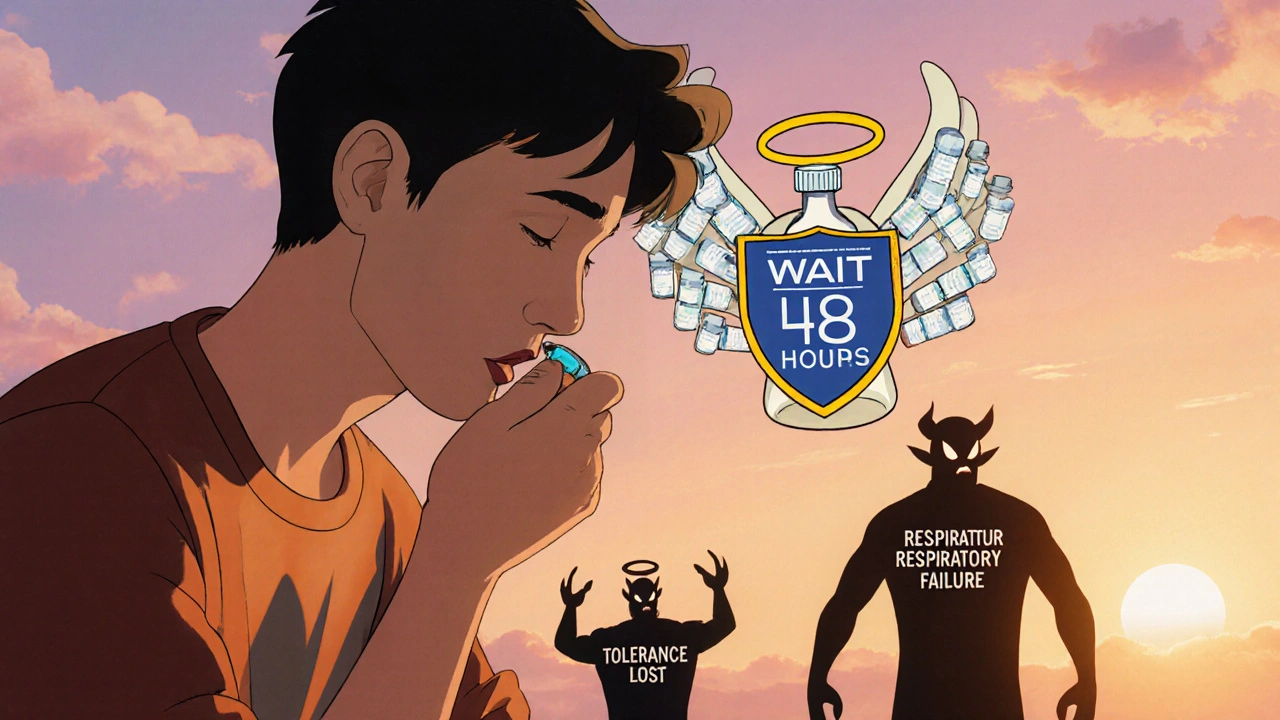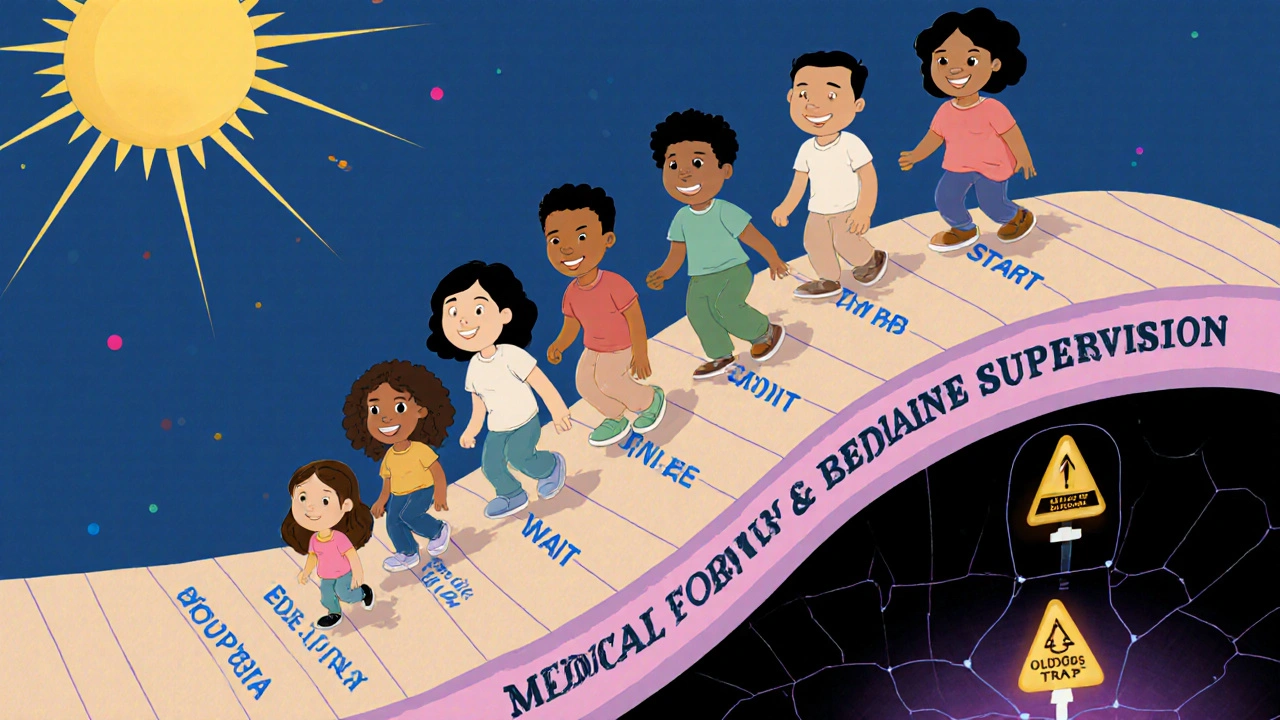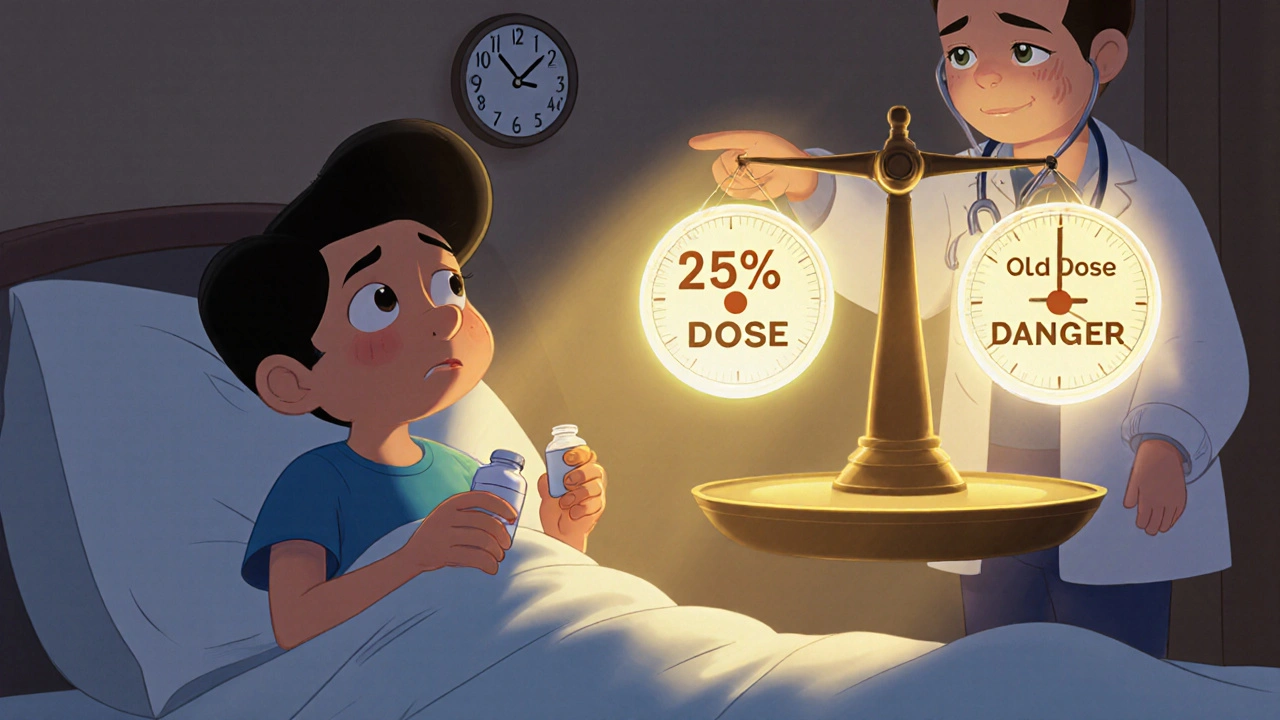Restarting a medication after taking a break can be deadly-even if you’ve taken it safely before. This isn’t about misuse or addiction. It’s about something simpler, and more dangerous: your body forgets how to handle the drug. When you stop taking a medication like an opioid, benzodiazepine, or even some antidepressants, your tolerance drops fast. Sometimes in just a few days. But your memory doesn’t. You remember the dose that worked before. So you take it again. And your body, now defenseless, can’t cope. The result? Respiratory failure, coma, or death.
Why Your Body Forgets How to Handle the Drug
Your body adapts to medications over time. That’s called tolerance. With opioids like oxycodone or methadone, your brain reduces its sensitivity to the drug. Your liver gets better at breaking it down. Your breathing slows less because your system has learned to expect it. But when you stop, that adaptation reverses. Fast.For short-acting opioids like heroin or hydrocodone, tolerance can drop by half in under a week. For methadone, it’s even faster-within 3 to 5 days, your body is back to near-naive status. That means the dose that once kept your pain under control could now shut down your breathing. The same goes for benzodiazepines like alprazolam or clonazepam. Your nervous system loses its balance. Restart at your old dose? You’re asking your brain to handle a flood when it’s only used to a trickle.
This isn’t theoretical. In 2022, the Washington State Department of Health found that 62% of fatal opioid overdoses happened within 72 hours of someone leaving jail, rehab, or the hospital. These were people who had been clean. Who thought they were safe. Who took their old dose-and didn’t wake up.
Which Medications Carry the Highest Risk?
Not all medications are equal when it comes to restart danger. Some are far more dangerous if you jump back in at your old dose.- Opioids (oxycodone, hydrocodone, fentanyl, methadone): Highest risk. Even a single dose can be fatal after a break. Fentanyl is especially deadly because it’s 50 to 100 times stronger than morphine. A dose that felt normal before can now be lethal.
- Benzodiazepines (alprazolam, diazepam, lorazepam): Risk of seizures, respiratory depression, and profound sedation. Tolerance fades quickly, but withdrawal symptoms can trick you into thinking you need your old dose.
- Antidepressants (especially SSRIs and SNRIs like paroxetine, venlafaxine): Restarting too soon after stopping can cause serotonin syndrome-a dangerous spike in brain serotonin. This can lead to fever, seizures, and heart rhythm problems.
- MAOIs (phenelzine, tranylcypromine): These require a full 2-week washout before switching to any other antidepressant. Restarting too soon can cause a life-threatening surge in blood pressure or serotonin toxicity.
- Antipsychotics (quetiapine, olanzapine): Restarting at previous doses can cause severe drops in blood pressure, dizziness, or fainting.
The key isn’t just the drug-it’s how long you’ve been off it. A 3-day break from oxycodone? Dangerous. A 3-week break from methadone? Even more so. And if you’ve been off for months? You’re essentially a new user.
The Safe Restart Protocol: Start Low, Go Slow
There’s one rule that saves lives: start at 25% to 50% of your previous dose. Then wait. And wait some more.Here’s how to do it right:
- Confirm you still need the medication. Talk to your doctor. Maybe your condition improved. Maybe you don’t need it anymore. Don’t restart just because you think you should.
- Ask for a lower starting dose. If your old dose was 40mg of oxycodone per day, start with 10mg. If it was 10mg of methadone, start with 2.5mg. For benzodiazepines, start at 25% of your previous daily total.
- Wait at least 24 to 48 hours before increasing. Your body needs time to adjust. Don’t rush. Don’t assume the first dose didn’t work. It’s not supposed to-yet.
- Increase slowly. Only raise the dose by 10% to 25% every few days. For opioids, increase no more than 5mg per day. For benzodiazepines, no more than 0.5mg every 3 to 5 days.
- Monitor for signs of overdose. Look for: breathing slower than 12 breaths per minute, blue lips or fingernails, unresponsiveness, pinpoint pupils, extreme drowsiness. If you see any of these, call 911 immediately.
This isn’t just advice-it’s standard protocol. The Calgary Clinical Pharmacology Service, the Washington State Department of Health, and the FDA all recommend this approach. Hospitals that follow it have seen overdose rates drop by more than 60%.

Never Restart Alone
Restarting medication after a break should never be done in isolation. You need someone nearby who knows what to do.Here’s what you must do before restarting:
- Get naloxone. This is a lifesaving drug that reverses opioid overdoses. It’s available over the counter in most states. Keep it with you. Give one to a friend, family member, or roommate. Teach them how to use it. Naloxone doesn’t work on benzodiazepines or antidepressants, but it’s essential if opioids are involved.
- Have a plan. Tell someone you’re restarting. Ask them to check on you the first day. If you’re not responding, they need to know to call 911 and give naloxone.
- Avoid alcohol and sleep aids. Mixing opioids or benzodiazepines with alcohol, sleeping pills, or even some cold medicines can multiply the risk of overdose. Even one drink can be deadly when you’re restarting.
One Reddit user, u/RecoveryWarrior, shared their story: “Took my usual 30mg oxycodone after 10 days off. Passed out. Woke up in the ER. Naloxone saved me. Never again.”
Medical Supervision Makes All the Difference
The safest way to restart any medication after a break is under professional care. This isn’t about being weak-it’s about being smart.Medically supervised restart programs are becoming more common. Evoke Wellness in Texas reports an 87% success rate for patients who restart under supervision, compared to just 42% for those who go it alone. Why? Because doctors can:
- Adjust doses based on your weight, age, liver function, and other medications.
- Use pharmacogenetic testing to see how your body metabolizes drugs.
- Monitor your breathing, blood pressure, and oxygen levels in real time.
- Prevent dangerous interactions (like restarting an SSRI too soon after an MAOI).
And if you’re coming out of jail, rehab, or the hospital? You’re at the highest risk. That’s why the CDC’s 2024 Overdose Prevention Plan prioritizes restart protocols in correctional facilities. $48.7 million is being spent to make sure people don’t die the moment they’re released.

What to Do If You’ve Already Overdosed
If you’ve had an overdose-even if you were revived with naloxone-you’re not safe. Your body is still adjusting. You may feel fine. But your tolerance is still low.Here’s what you must do:
- Do not take any more of the drug for at least 72 hours. Even if you’re in pain or anxious. Your body is still recovering.
- Get evaluated by a doctor. They’ll check your organ function, especially your liver and lungs.
- Start over from scratch. Don’t try to “get back to your old dose.” You’re not the same person you were before. Your body isn’t the same.
- Consider long-term alternatives. Extended-release naltrexone (Vivitrol) can block opioids for 30 days and reduce relapse risk by 73%. Talk to your doctor about it.
Future Tools to Prevent Overdose
The science is catching up. New tools are emerging to make restarts safer:- Wearable monitors that track breathing and automatically deliver naloxone if levels drop too low. These are in Phase 3 trials and could be available by 2026.
- Pharmacogenetic tests that analyze your DNA to predict how fast you break down drugs. This helps doctors pick the right starting dose.
- AI-powered risk calculators used in clinics that factor in your abstinence time, past dose, age, and other medications to give you a personalized restart plan.
These aren’t sci-fi. They’re real. And they’re being used now in major hospitals across the U.S.
Final Reminder: Your Past Dose Is Not Your Safe Dose
The biggest mistake people make is assuming their old dose still works. It doesn’t. Your body changed. Your tolerance changed. Your risk changed.If you’re restarting a medication after a break:
- Start at 25% to 50% of your old dose.
- Wait at least 24 to 48 hours before increasing.
- Never restart alone.
- Have naloxone on hand if opioids are involved.
- Get medical help. Don’t guess. Don’t risk it.
This isn’t about fear. It’s about respect. Respect for your body. Respect for the drug. And respect for the fact that you’re alive-so you can live well.
Can I restart my medication on my own after a week off?
No. Even after a week off, your tolerance is significantly reduced-especially with opioids and benzodiazepines. Restarting at your previous dose can cause respiratory failure. Always start at 25% to 50% of your old dose and increase slowly under medical supervision.
How long does it take to lose tolerance to opioids?
Tolerance to short-acting opioids like oxycodone or heroin can drop by half in as little as 3 to 5 days. For methadone, it can take 7 to 10 days. After a month off, you’re essentially back to the tolerance level of someone who has never used the drug.
Is naloxone safe to use if I’m not sure it’s an overdose?
Yes. Naloxone only works on opioids and has no effect if opioids aren’t in the system. It’s safe to use even if you’re unsure. Giving naloxone to someone who overdosed on opioids can save their life. Not giving it could kill them.
Can I restart antidepressants after stopping them?
Yes, but timing matters. For SSRIs and SNRIs, restarting too soon after stopping can cause serotonin syndrome. For MAOIs, you must wait at least 2 weeks before starting any other antidepressant. Always consult your doctor before restarting any psychiatric medication.
What if I feel fine after restarting at my old dose?
Feeling fine doesn’t mean you’re safe. Overdose symptoms can appear hours later. Respiratory depression can be silent. You may feel okay now but still be at risk of sudden collapse. Never assume safety based on how you feel. Stick to the slow restart protocol.


Suzan Wanjiru
November 21, 2025
I restarted my oxycodone after 12 days off and took my old 40mg. Woke up in the ER with my brother screaming for naloxone. Never again. Start at 10mg. Seriously. Your body forgets faster than you think.
Don't be that guy.
Kezia Katherine Lewis
November 23, 2025
From a clinical pharmacology standpoint, the pharmacokinetic half-life of opioid receptor downregulation is highly variable but generally aligns with the 72-hour window cited in the post. What's often underappreciated is the neuroadaptive plasticity of mu-opioid receptor internalization-this isn't just tolerance, it's receptor trafficking collapse. The body doesn't 'forget'-it actively deconstructs the molecular machinery that once accommodated the drug.
That's why 25% dosing isn't conservative-it's biologically mandatory.
Henrik Stacke
November 24, 2025
Oh my god, this is so important. I had a cousin who died last year-just came out of rehab, took his old dose, never woke up. I cried for three days. This post? It’s a lifeline.
And yes, naloxone should be as common as fire extinguishers. We need to hand it out like candy at festivals. I carry two in my bag. My partner doesn’t even ask why anymore.
Don’t wait until it’s too late. Please.
Jennifer Skolney
November 24, 2025
Just had to share-my mom restarted her clonazepam after 3 weeks off and went from 2mg to 1mg like the post said. She said she felt like a new person. No dizziness, no brain fog, no panic. Just calm. I cried reading this. Thank you for putting this out there. 🙏
And yes, I bought her naloxone too. Just in case.
JD Mette
November 26, 2025
I’ve seen this too many times in ER. Someone comes in after a weekend away from their meds, takes their usual dose, and ends up on a ventilator. It’s heartbreaking. The worst part? They always say, ‘But I’ve taken this before.’
Yeah. But your body didn’t.
Olanrewaju Jeph
November 27, 2025
It is imperative that individuals who intend to resume pharmacological therapy after a period of abstinence adhere strictly to the principle of dose titration. The human body exhibits remarkable homeostatic plasticity, and the downregulation of drug-specific receptors occurs rapidly during withdrawal. Consequently, the administration of a previously tolerated dosage constitutes a pharmacological hazard. I recommend that all patients consult with their prescribing physician to establish a personalized reinitiation protocol based on pharmacokinetic and pharmacodynamic parameters.
Dalton Adams
November 29, 2025
LMAO you guys are overcomplicating this. I’ve been on methadone for 12 years. Took 10 days off after a family emergency. Came back and hit 80mg. Felt fine. No problem. You think your body ‘forgets’? Nah. Your body remembers. It’s your brain that’s scared.
Also, naloxone is for weaklings. If you can’t handle your dose, don’t take it. And don’t act like this is some revolutionary insight-this is basic pharmacology 101. I’ve got a PhD in neuropharmacology. I’ve seen it all.
PS: Naloxone doesn’t work on benzos, so why are you even mentioning it? You’re just fearmongering. 😎
Javier Rain
December 1, 2025
Dalton, you’re lucky you’re alive. That’s not bravery, that’s Russian roulette with your brainstem.
And if you think this is ‘basic pharmacology,’ you clearly haven’t read the CDC’s 2024 overdose report or the Washington State data I linked. People die because someone like you thinks they’re invincible.
Get your head out of your ass. This isn’t about ego. It’s about people who didn’t get a second chance. Start low. Stay alive. That’s not advice. That’s survival.